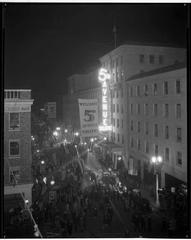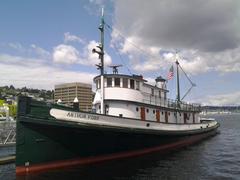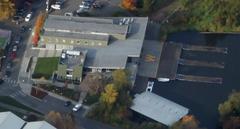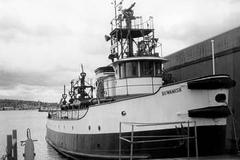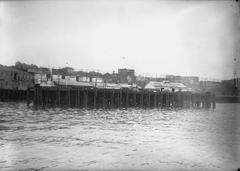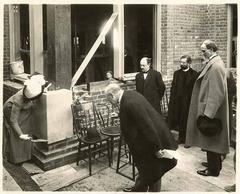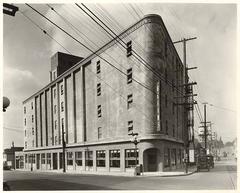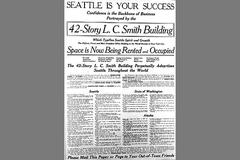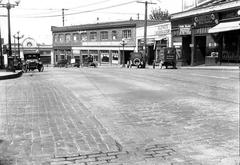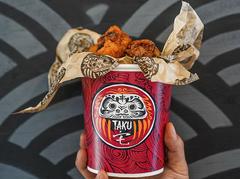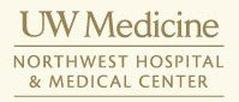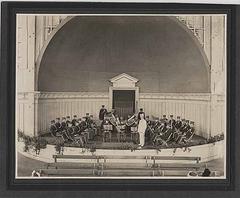George Washington Memorial Bridge (Aurora Bridge) Seattle: Visiting Hours, Tickets, and Travel Guide
Date: 04/07/2025
Introduction
The George Washington Memorial Bridge, better known as the Aurora Bridge, is a prominent symbol of Seattle’s architectural ingenuity and historical legacy. Spanning the Lake Washington Ship Canal, this remarkable steel structure connects the Queen Anne and Fremont neighborhoods, serving as a critical part of State Route 99. Since its completion in 1932 to honor George Washington’s bicentennial, the bridge has stood as a testament to Seattle’s growth and innovation, carrying tens of thousands of vehicles each day and offering pedestrians and cyclists striking views of the city, Lake Union, and the surrounding landscape.
With round-the-clock accessibility and no entrance fees, the Aurora Bridge is both a vital transportation artery and a must-see destination for visitors. Its proximity to local attractions such as the Fremont Troll, Gas Works Park, and the creative Fremont neighborhood further enhances its appeal. This comprehensive guide covers everything you need to know for a safe, enjoyable, and memorable visit—from historical background and engineering highlights to practical travel information and local tips (PCAD; Wikipedia DE; HistoryLink).
Table of Contents
- Historical Background
- Visitor Information
- Notable Events
- Frequently Asked Questions (FAQ)
- Plan Your Visit
- Summary and Visit Tips
- References and Further Reading
Historical Background
Planning, Construction, and Design
Constructed to complete a vital link across the Lake Washington Ship Canal, the Aurora Bridge was envisioned as a solution to Seattle’s increasing transportation demands. Construction began in 1929, led by the firm Jacobs and Ober, with the steelwork commencing in 1931. The bridge officially opened on February 22, 1932, as part of the bicentennial celebrations of George Washington’s birth (PCAD). Its steel cantilever and truss design, stretching nearly 2,955 feet long and 70 feet wide, allowed for high vehicle capacity while maintaining a 167-foot clearance for maritime traffic—a significant improvement over previous crossings (Wikipedia DE).
Engineering and Architectural Significance
At the time of its opening, the Aurora Bridge was the second-longest steel cantilever bridge in Washington. Its Art Deco architectural details, riveted steel construction, and functional elegance earned it a spot on the National Register of Historic Places in 1982 (PCAD). The bridge remains a major thoroughfare and a much-photographed Seattle icon.
Visitor Information
Accessibility and Visiting Hours
- Open 24/7: The Aurora Bridge is accessible at all hours for vehicles, pedestrians, and cyclists.
- No Entrance Fees or Tickets: There are no admission costs or ticket requirements.
- Pedestrian and Cyclist Access: Sidewalks exist on both sides, but they are narrow and adjacent to traffic. Daytime visits are strongly recommended for safety.
Parking and Transportation
- Parking: No dedicated parking is provided at the bridge, but ample street parking is available in nearby Fremont and Queen Anne neighborhoods. Always check posted restrictions.
- Public Transit: Several Metro bus routes serve the area, including Route 26 and others via Aurora Avenue. The Link Light Rail and connecting buses offer convenient options (Evendo).
- Cycling and Walking: Seattle’s bike network connects to the bridge, but extra caution is needed due to the narrow sidewalks and proximity to traffic.
Scenic Viewpoints and Photography
- On the Bridge: The bridge itself offers panoramic views of Lake Union, the Olympic Mountains, and the Seattle skyline, especially during sunrise and sunset.
- Nearby Parks: For safer and more comfortable photography, visit Gas Works Park or Fremont Peak Park, both offering spectacular vantage points (Tour in Planet).
Nearby Attractions
- Fremont Troll: Located under the bridge’s north end, this quirky sculpture is a favorite stop for photos and a symbol of Fremont’s unique culture (Wikipedia DE).
- Gas Works Park: Just east of the bridge, the park provides sweeping views of Lake Union and downtown Seattle.
- Fremont Neighborhood: Known for its eclectic shops, public art, and dining options, Fremont is ideal for pre- or post-bridge exploration.
- Lake Union Activities: Kayaking, paddleboarding, and boat tours offer memorable perspectives of the bridge from the water (AAA Trip Canvas).
Safety and Precautions
- Sidewalks: They are less than 46 inches wide and not wheelchair accessible. Use marked pedestrian paths and be alert to traffic.
- Upgrades: Safety features include seismic retrofitting, improved lighting, suicide-prevention barriers, and emergency phones.
- Weather: Seattle’s weather is variable; dress in layers and prepare for rain (Visit Seattle City).
Notable Events
The Aurora Bridge has played a role in key Seattle moments—from its grand opening featuring a symbolic log-cutting and a remote salute from President Herbert Hoover, to tragic incidents like the 1998 bus accident that brought changes to local transit safety policies (Wikipedia DE). The bridge was also a backdrop for the 1962 Seattle World’s Fair and continues to be celebrated in city art and festivals.
Frequently Asked Questions (FAQ)
Q: What are the Aurora Bridge visiting hours?
A: The bridge is open 24/7 to vehicles, pedestrians, and cyclists.
Q: Is there an entrance fee or ticket required?
A: No, access to the bridge is free.
Q: Is the bridge wheelchair accessible?
A: The sidewalks are narrow and not fully wheelchair accessible, but nearby parks and Fremont’s main streets offer better accommodations (Evendo).
Q: Where are the best photo spots?
A: Gas Works Park and Fremont Peak Park provide safe, scenic vantage points.
Q: Is it safe to walk across the bridge?
A: Yes, but exercise caution due to narrow sidewalks, traffic, and weather conditions.
Q: Are guided tours available?
A: No official tours are conducted on the bridge, but many Seattle city tours include stops at nearby attractions.
Plan Your Visit
- Best Time to Visit: Summer (June–September) offers clear views and pleasant weather, though crowds are higher. Early mornings and weekdays are quieter.
- Combine Destinations: Pair your visit with Kerry Park or the Space Needle for more iconic city vistas (Tour in Planet; Postcards to Seattle).
- Dining: Explore Fremont’s local restaurants and cafes, such as Fremont Brewing, Cafe Turko, and Theo Chocolate.
- Responsible Tourism: Use public transit, support local businesses, and help preserve Seattle’s green spaces (The Broke Backpacker).
Summary and Visit Tips
The Aurora Bridge is a living emblem of Seattle’s spirit, combining historical significance, engineering excellence, and cultural vibrancy. Its striking structure and scenic views attract history buffs, photographers, and explorers alike. While pedestrian access is limited by narrow sidewalks, nearby parks and neighborhoods offer accessible and enriching experiences. With no entrance fees and 24/7 access, the bridge is an essential stop for any Seattle visitor. For an optimal experience, visit during daylight hours, explore nearby attractions, and tap into local resources such as the Evendo app for real-time updates and self-guided tours.
References and Further Reading
- This article draws on detailed sources for historical background, visitor guidance, and local insights:
Plan your Seattle adventure and let the Aurora Bridge inspire your journey through the Emerald City.
